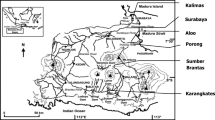Abstract
Cadmium and mercury concentrations were measured in the tissues of 64 individual albatrosses [23 wandering albatrosses (Diomedea exulans), 9 royal albatrosses (Diomedea epomophora) and 32 shy albatrosses (Thalassarche cauta)] which were killed as by-catch in longline fishing activities between 1991 and 1994. Mercury concentrations were also determined for 33 shy albatross eggs (excluding shells). The birds were all sexed and assigned to one of two age classes (immature and adult). The three species exhibited differences both in overall concentrations of cadmium and mercury, and also in the pattern of accumulation of metals with age and sex. Wandering albatrosses exhibited the highest mercury concentrations with a mean concentration in adult liver samples of 920.0 ± 794.1 μg g−1 dry weight. Shy albatrosses had the lowest mercury concentrations with mean concentrations in adult livers of 36.3 ± 21.4 mg g−1 dry weight. The highest mercury concentration was 1800 μg g−1 for an adult female wandering albatross. Cadmium concentrations were less variable, with adult royal albatrosses having the highest average concentrations (180.0 ± 165.0 in adult kidneys) and adult shy albatrosses the lowest (40.1 ± 20.0 in adult kidney). The highest individual cadmium concentration was 287 μg g−1 for a juvenile wandering albatross. There was no evidence of increased accumulation of cadmium with age in any of the species, but wandering albatrosses showed higher mercury concentrations in adults than juveniles. Female wandering albatrosses also had significantly higher mercury concentrations than males. The mercury contents of the shy albatross eggs were very low, with a maximum concentration of 5.4 μg g−1. The results of this study are consistent with the findings of previous work on albatrosses and support the notion that the life-history strategy of these species (i.e. long-lived with low reproductive output) may be an important determinant in the concentrations of some metals found in their tissues.
Similar content being viewed by others
Author information
Authors and Affiliations
Additional information
Accepted: 15 February 1999
Rights and permissions
About this article
Cite this article
Hindell, M., Brothers, N. & Gales, R. Mercury and cadmium concentrations in the tissues of three species of southern albatrosses. Polar Biol 22, 102–108 (1999). https://doi.org/10.1007/s003000050396
Issue Date:
DOI: https://doi.org/10.1007/s003000050396




